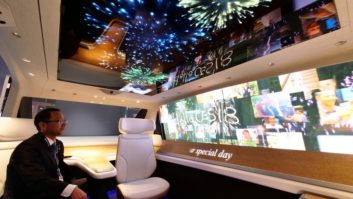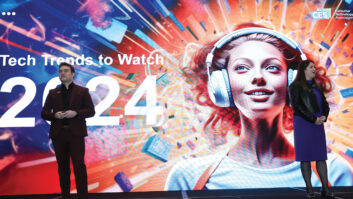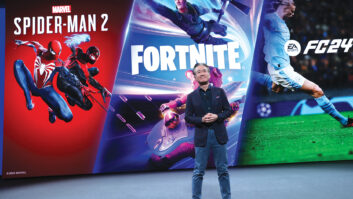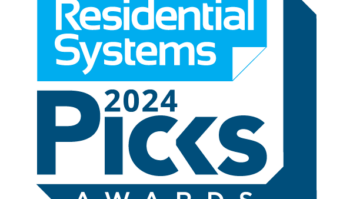Day 1 of the 2018 International Consumer Electronics Show kicked off in full swing, and my opening morning found me at the Sands Expo where many of the smart home products are showcased. It didn’t take long – in fact before even stepping into the first hotel – to see that Google had brought its voice assistant to Vegas in a huge way. Up and down the strip were banners, monorail audio ads, and even massive hotel LED signs advertising the “Hey, Google” voice assistance service.
[Get this kind of CE coverage all year long — subscribe to the free Residential Systems eNewsletter.]

Once inside the halls, white clad jumpsuit wearing “Google Assistant” helpers seemed to be everywhere, including helping out in multiple booths, ready to show off Google voice assistant in action. Walking the floor it would be easy to think, “Alexa who?” as Google clearly shelled out a lot of cash to make a major play in the smart home space. And it totally paid off in exposure.

Google showed a lot of support in the Z-Wave Alliance booth, being part of many demonstrations there. One cool and noteworthy product was Hogar Controls’ Milo, the world’s first Z-Wave hub with Google Assistant built right in.

The benefit of this is simpler integration, with one device that not only serves as the connection nexus for all Z-Wave wireless communication, but that can also offer full voice control and provide all of Google’s assistant services.

Also on hand were a host of new start-up smart home automation companies, with many embracing Google Assistant or Apple’s HomeKit, and sometimes both. Everything is about being smart, connected, and app-based. This was noticeable not only in whole-home controls but in the vast number of smart doorlocks/doorbells, thermostats, and camera/surveillance systems on display.


Beyond bigger megapixel lenses and better night vision, many new surveillance/security cameras are touting is intelligence—the ability to discern faces, to set boundaries and perimeters, and to eliminate false alarms and only capture actual events.

One camera that impressed me was the Brinks Array Video Coach Light. This comes in three different styles and is designed to blend in and not look like a camera while still retaining next-gen performance and surveillance. Brinks also showed a new doorlock that used solar power to charge its internal battery.

Another Google-enabled product that caught my eye was the First Alert Onelink Safe & Sound. This embeds Google Assistant along with a full speaker into a ceiling mounted smoke and carbon monoxide alarm. It offers a customizable night light, plays music and answers “Hey, Google” questions, and also links to other Onelink devices in the home to sound a whole-house alarm in the event of an emergency. Coming next year the device will also include a Wi-Fi mesh network repeater!

Beyond touting voice control integration with the Big Three—Google Assistant, Amazon Alexa, and Apple Siri, Fibaro showed off its first Apple HomeKit-enabled products. Currently, this is limited to The Button multi-controller, flood sensor, motion sensor, and door/window sensor, but more devices are on the way. Fibaro also wanted to stress its support for the integrator channel, stressing the company is available in 110 countries with an in-depth community that constantly writes and updates drivers and a “works with Fibaro” slogan.

In a suite in the Venetian, Sandy Gross of GoldenEar Technology unveiled what is likely the most premium Google Chromecast speaker to date. Sandy had a non-working sample of the company’s forthcoming DigitalAktiv 3 powered, wireless bookshelf loudspeaker. The speaker will feature technology based on GoldenEar’s flagship Triton Reference, but will have driven by an internal 260-watts worth of power and incorporate a 56-bit DSP engine. The speakers will accept audio via Bluetooth or from Chromecast. When two speakers are paired together, they will use WISA’s ultra-low latency signal to create a stereo pair. The speaker will also be able to use WISA to send signals wirelessly to a subwoofer. Sandy expects the speakers to be available around CEDIA time for $2,000/pair.

In non-Google related news, Nortek Security was showing off the tight integration between two of the company’s brands, Elan and 2GIG. Elan g! systems now fully integrate with 2GIG’s latest GC3 panels, creating a seamless user experience across a variety of Elan controllers as well as easy integration for the installer.

Nortek also showed off an ingenious—and potentially lifesaving—new device called the Stove and Grill Guard. The simple black ring fits until most grill and stove knobs and then wirelessly alerts the security system if a programmed event takes place, such as the stove turning on at a time when it shouldn’t, or being left on for too long a time. These will be reasonably priced and have a three- to five-year battery life.

On the Elan front, the new OS 8.2 software will be coming next week and it includes some new views and themes for the screen GUI. Additionally designers will be able to import 2D JPEG or PNG drawings of a project and then use the g! configurator software to render 3D models. The look is visually impressive and will give homeowners a quick snapshot of what is happening all around the home. The company will also be launching a new, lower-priced HR10 remote control, as well as a replacement for the HR200, the new HR30 that will feature updated cosmetics, more powerful Wi-Fi and a swipeable touchscreen.







